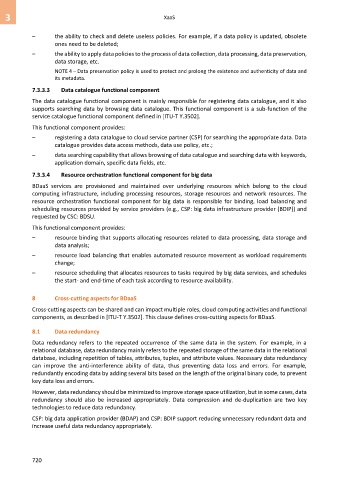Page 728 - Cloud computing: From paradigm to operation
P. 728
3 XaaS
– the ability to check and delete useless policies. For example, if a data policy is updated, obsolete
ones need to be deleted;
– the ability to apply data policies to the process of data collection, data processing, data preservation,
data storage, etc.
NOTE 4 – Data preservation policy is used to protect and prolong the existence and authenticity of data and
its metadata.
7.3.3.3 Data catalogue functional component
The data catalogue functional component is mainly responsible for registering data catalogue, and it also
supports searching data by browsing data catalogue. This functional component is a sub-function of the
service catalogue functional component defined in [ITU-T Y.3502].
This functional component provides:
– registering a data catalogue to cloud service partner (CSP) for searching the appropriate data. Data
catalogue provides data access methods, data use policy, etc.;
– data searching capability that allows browsing of data catalogue and searching data with keywords,
application domain, specific data fields, etc.
7.3.3.4 Resource orchestration functional component for big data
BDaaS services are provisioned and maintained over underlying resources which belong to the cloud
computing infrastructure, including processing resources, storage resources and network resources. The
resource orchestration functional component for big data is responsible for binding, load balancing and
scheduling resources provided by service providers (e.g., CSP: big data infrastructure provider (BDIP)) and
requested by CSC: BDSU.
This functional component provides:
– resource binding that supports allocating resources related to data processing, data storage and
data analysis;
– resource load balancing that enables automated resource movement as workload requirements
change;
– resource scheduling that allocates resources to tasks required by big data services, and schedules
the start- and end-time of each task according to resource availability.
8 Cross-cutting aspects for BDaaS
Cross-cutting aspects can be shared and can impact multiple roles, cloud computing activities and functional
components, as described in [ITU-T Y.3502]. This clause defines cross-cutting aspects for BDaaS.
8.1 Data redundancy
Data redundancy refers to the repeated occurrence of the same data in the system. For example, in a
relational database, data redundancy mainly refers to the repeated storage of the same data in the relational
database, including repetition of tables, attributes, tuples, and attribute values. Necessary data redundancy
can improve the anti-interference ability of data, thus preventing data loss and errors. For example,
redundantly encoding data by adding several bits based on the length of the original binary code, to prevent
key data loss and errors.
However, data redundancy should be minimized to improve storage space utilization, but in some cases, data
redundancy should also be increased appropriately. Data compression and de-duplication are two key
technologies to reduce data redundancy.
CSP: big data application provider (BDAP) and CSP: BDIP support reducing unnecessary redundant data and
increase useful data redundancy appropriately.
720

